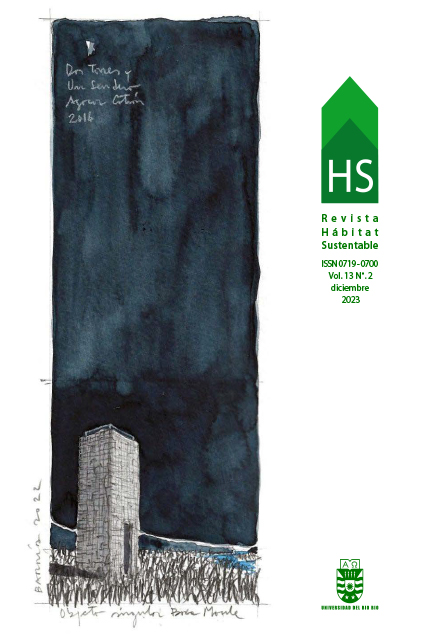Review of "lightened slipstraw ceilings" as a cultural practice in the vernacular roofing of Aymara houses in Arica and Parinacota, Chile
DOI:
https://doi.org/10.22320/07190700.2023.13.02.03Keywords:
earth construction, vernacular architecture, natural fibers, thermal insulation, IchuAbstract
This article reviews the slipstraw ceiling technology known in the Aymara language as "caruna.” The study was made in Aymara homes at more than 4,000 meters above sea level in the town of Tacora, in the region of Arica and Parinacota, Chile, as part of project 49204, financed by the National Cultural Heritage Service. It aims to recover this vernacular technique as an alternative to industrialized materials that have modified Andean housing and the quality of life in extreme climates over the last 25 years. Samples of materials used in this technique, reproduced by a local craftsman, were collected and analyzed in the laboratory to determine their thermal properties and workability. The energy performance of three homes in Tacora was also monitored to compare the results obtained with those of the laboratories. The findings revealed that the mud mold used in this ceiling technique is predominantly made from clay with medium compressibility and low thermal conductivity, which makes it apt for insulation in cold desert climates. Lightened clay and straw ceilings stand out in the local culture thanks to the availability of material resources and ease of installation. This study highlights the importance of preserving traditional knowledge, respecting ancestral knowledge, and improving the thermal performance of homes in the northern mountain range of Chile, Peru, and Bolivia, highlighting its relevance for developing sustainable and culturally relevant housing solutions.
Downloads
References
AZA-MEDINA, L. C., PALUMBO, M., LACASTA, A. M., & GONZÁLEZ-LEZCANO, R. A. (2023). Characterization of the termal behavior, mechanical resistance, and reaction to fire of Totora (Schoenoplectus Californicus (C.A. Mey.) SoJAK) panels and their potential use as a sustainable construction material. Journal of Building Engineering, 69, 105984. https://doi.org/10.1016/j.jobe.2023.105984
CHARCA, S., NOEL, J., ANDIA, D., FLORES, J., GUZMAN, A., RENTEROS, C., & TUMIALAN, J. (2015). Assessment of Ichu fibers as nonexpensive thermal insulation system for the Andean regions. Energy and Buildings, 108, 55-60. https://doi.org/10.1016/j.enbuild.2015.08.053
DIRECCIÓN DE ARQUITECTURA, MINISTERIO DE OBRAS PÚBLICAS. (2016). Guía de Diseño Arquitectónico AYMARA para edificios y Espacios públicos. https://repositoriodirplan.mop.gob.cl/biblioteca/server/api/core/bitstreams/cd7a8ae4-2abf-4b46-95f7-1edbf9e69f73/content
FANGER, O. P. (1973). Thermal Comfort: Analysis and Applications in Environmental Engineering. Danish Technical Press.
GARCÍA M., CASTRO, V., BELMONTE, E., MUÑOZ, T., SANTORO, C., & ECHEVERRÍA, J. (2018): Etnobotánica y territorio en el pastal de Mulluri (Norte de Chile). Las enseñanzas del pastoreo Aymara. Latin American and Caribbean Bulletin of Medicinal and Aromatic Plants, 17(5), 522-540. https://blacpma.ms-editions.cl/index.php/blacpma/article/view/135
GAVILÁN, V. & VIGUERAS, P. (2020). Embodied temporalities and memories in aymara rituals in northern Chile. Cultura y religión, 14(2), 100-127. https://dx.doi.org/10.4067/S0718-47272020000200107
HIDALGO-CORDERO, J. F., & AZA-MEDINA, L. C. (2023). Analysis of the thermal performance of elements made with totora using different production processes. Journal of Building Engineering,
, 105777. https://doi.org/10.1016/j.jobe.2022.105777
JORQUERA, N. (2014). Culturas sísmicas: estrategias vernaculares de sismorresistencia del patrimonio arquitectónico chileno. Arquitectura del Sur 32(46), 18–29. http://revistas.ubiobio.cl/index.php/AS/article/view/739
MELI G., ONNIS S., & WIESER M. (2019). Introducción en el contexto peruano de un nuevo sistema constructivo con madera y tierra alivianada. Seminario Iberoamericano de Arquitectura y Construcción con Tierra, 19. FUNDASAL /PROTERRA. p. 604-613, https://repositorio.pucp.edu.pe/index/handle/123456789/187747
MINVU. (2006). Manual de aplicación de reglamentación térmica (Ordenanza General de Urbanismo y Construcciones). https://es.scribd.com/document/50958657/Manual-de-Aplicacion-dela-Reglamentacion-Termica-Chile-Parte1
NOAMAN, M. F., KHAN, M. A., & ALI, K. (2022). Effect of artificial and natural fibers on behavior of soil. Materials Today: Proceedings, 64, 481-487 https://doi.org/10.1016/j.matpr.2022.04.954
PALME, M., GUERRA, J., & ALFARO, S. (2012). Earth of the Andes Comparing techniques and materials used in houses in San Pedro de Atacama. En PLEA 2012 - 28th Conference, Opportunities, Limits & Needs Towards an environmentally responsible architecture. https://www.researchgate.net/publication/250917170_Earth_of_the_Andes_Comparing_techniques_and_materials_used_in_houses_in_San_Pedro_de_Atacama
PALME, M., GUERRA, J., & ALFARO, S. (2014). Thermal Performance of Traditional and New Concept Houses in the Ancient Village of San Pedro De Atacama and Surroundings. Sustainability 6(6), 3321-3337. https://doi.org/10.3390/su6063321
PEEL, M. C., FINLAYSON, L., & MCMAHON, T. A. (2007). Updated World Map of the Köppen-Geiger Climate Classification. Hydrology and Earth System Sciences, 11(5), 1633-1644. https://doi.org/10.5194/hess-11-1633-2007
PEREIRA, M. & YUSTE, B. (2019). El último Mallku. Paisaje cultural de Tacora. Fundación Altiplano. https://issuu.com/fundacionaltiplano/docs/el_u_ltimo_mallku._paisaje_cultural_de_tacora
ŠOLC, V. (2011). Casa Aymara en Enquelga. Chungara, 43(1), 89-111. https://doi.org/10.4067/s0717-73562011000100006
VINCESLAS, T., COLINART, T., HAMARD, E., MENIBUS, A.H., LECOMPTE, T., & LENORMAND, H. (2019). Light Earth Performances for Thermal Insulation: Application to Earth–Hemp. Earthen Dwellings and Structures, 357-367. https://doi.org/10.1007/978-981-13-5883-8_31
VOLHARD, F. (2016). Light earth building: A handbook for building with wood and earth. Birkhäuser. https://doi.org/10.1515/9783035606454
WEBER, D.J., ZAMBRANO, F.C., VILLAR, T.C., & DÁVILA, M.B. (1998). Rimaycuna Quechua de Huánuco: Diccionario del Quechua del Huallaga con Índice Inglés (Serie Lingüística Peruana). Instituto Lingüística de Verano.(pp. 126)
WIESER, M., ONNIS, S., & MELI, G. (2020). Desempeño térmico de cerramientos de tierra alivianada : posibilidades de aplicación en el territorio peruano. Revista de Arquitectura, 22(1), 164–174. https://doi.org/10.14718/RevArq.2020.2633
YÁÑEZ, C. A., & CAPELLA, C. (2021). Construcción de identidad personal en niños y niñas aymara residentes en Chile. Revista De Psicología, 30(2). https://doi.org/10.5354/0719-0581.2021.60644
Downloads
Published
How to Cite
Issue
Section
License
Copyright (c) 2023 Sergio Alfaro-Malatesta, Massimo Palme, Jocelyn Cohen-Herera

This work is licensed under a Creative Commons Attribution-ShareAlike 4.0 International License.
The content of articles which are published in each edition of Habitat Sustentable, is the exclusive responsibility of the author(s) and does not necessarily represent the thinking or compromise the opinion of University of the Bio-Bio.
The author(s) conserve their copyright and guarantee to the journal, the right of first publication of their work. This will simultaneously be subject to the Creative Commons Recognition License CC BY-SA, which allows others to share-copy, transform or create new materials from this work for non-commercial purposes, as long as they recognize authorship and the first publication in this journal, and its new creations are under a license with the same terms.











 Scientific Information Program/Concurso Fondos de Publicación de Revistas Científicas 2018/ Proyecto Mejoramiento de Visibilidad de Revistas UBB (Código:FP180007).
Scientific Information Program/Concurso Fondos de Publicación de Revistas Científicas 2018/ Proyecto Mejoramiento de Visibilidad de Revistas UBB (Código:FP180007).





